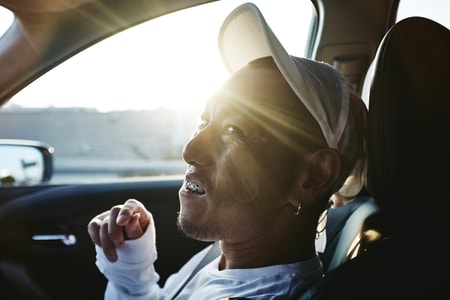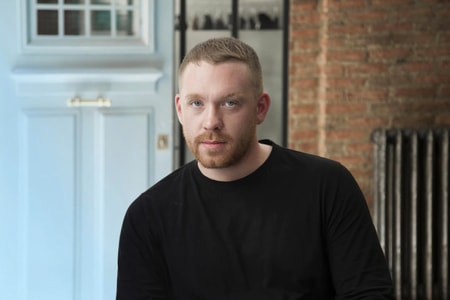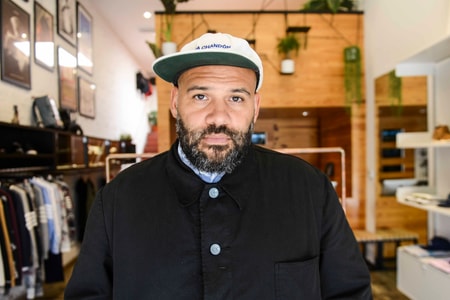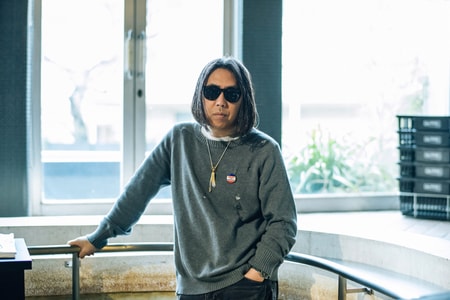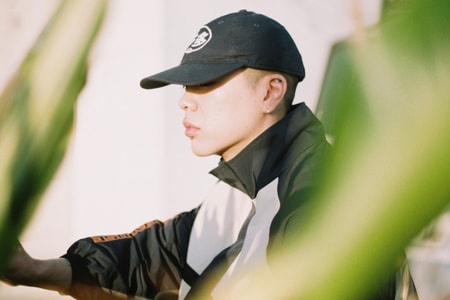
Since starting your brand, what are the biggest challenges you’ve faced? What have been your biggest learnings?
To me there are new challenges every day. At the beginning, it was simply identifying what I wanted to say and do with the brand, such as making clothes exactly as I pictured in my mind and proving a right to have them exist in the industry. Even at this point in time it is still a constant and difficult process to get the method and different people I collaborate with up to par for a single piece of clothing. As a young brand that has limited money to work with artisans or factories, there was a lot of speaking and convincing I had to do to get me to this point now.
One of the recent challenges is making the brand feel cohesive down to every bit of communication we do—from test, imagery and experience to the final product. Fashion is so fast that sometimes you don’t take the time to delve into smaller decisions. But everything is so important. I myself am trying to understand the brand as what I want it to be as a whole 10 years or 20 years from now. I want to execute the things I believe into reality... which is my clothing. Finding world-class talent to work with takes a lot of time. With all the money and all the budget in the world it is still difficult to find great people to work with you because great people have jobs too. These challenges come back everyday as time goes on.
How has being based in Europe affected your approach to design? What is America lacking when it comes to design?
Having made clothes in America and Asia before, it was really eye opening for me to get access to the manufacturing and fabric development in Italy. It was nice to have that kind of liberty. Back in LA, if I wanted to work on a certain leather piece or some funky knitwear garment, I was limited by the materials or the knowledge of the supplier, etc. Working in Europe gave me zero limitations which is amazing... but also intimidating as I have to create boundaries for myself. Sometimes when you have everything, it’s hard not to be tempted to use them all.
The fashion industry has experienced a lot of ups and downs in recent years. What do you think about the current state of the industry and what do you see as the biggest issues facing the industry today?
Starting a fashion brand is super hard. As a young person starting a business, having to do all the different things that are involved is not easy. We are designing things under a microscope which people could use to keep track of our learning curve, whereas in the past brands like Raf Simons would have time to cultivate what they say.
Being able to learn what feels right to you through the act of doing is what I’ve been doing these past three years. It’s hard to keep a brand, to make things, to run a business in a lot of cities which have super expensive living costs. Then there is also data-driven commerce, which takes the complete creativity out of a buyer who may have used to be a co-curator of the product and how it was shown to the customer. But now that things are strictly data-driven, you just get more of the same products with no risk. Fashion should be built on risk and the risk takers—the people who are doing things as a reaction of their current state of living.
How has it been collaborating with such a massive label like Vans? What kind of compromises needed to made, if any?
It was great collaborating with so many bigger brands. As with anything, everybody has their goals for a collaboration. There can be no downfall in collaborating. To be able to work with fragment design, in terms of it being a global project, that was rare because in Japan everything has to be licensed. To be able to have our brands showcased throughout every region, that was amazing.
Do musical references inspire your designs?
Music is so connected to clothing to the extent that how I got into designing clothes was probably through listening to music and living the nightlife. But I wasn’t actively inspired by music in my pieces.
What are your short-term and long-term goals for your brand, and personally?
I’ve been really inspired by Yvon Chouinard from Patagonia. He is a big inspiration for me as like a business owner and the model he has created for the brand. My goal is to have Alyx be a company that is around for many decades. Yvon talks about him making decisions for the company as if it’s going to be around for a hundred years.
He wanted it to be a business model for future companies to make products and be conscious of their effect on their environment. Regardless if it’s a nature-conscious brand or current aesthetics like Alyx, I like this idea of a brand being able to be a modern model that can be successful and can communicate to our customers, make great quality clothing, and support and engage with the community.
Being a brand that other people will emulate in the future would be my goal. I want more people to create new things. I want more people to care about why things exist and design things with integrity and responsibility. I don’t think there is enough of that right now. Somehow we can be influential and have others emulate what we do. That would be a huge success for me.





